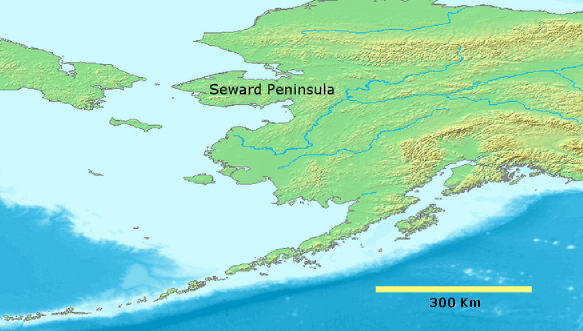
Nome, Alaska, aerial view, 2006. Photo: ra64
I have always found an eerie beauty to the vast wastes of the north. Places like Nome, Alaska literly lie at the end of the world. Isolated from where everyone else lives, these places are mysterious and lonely.
Nome lies on the west central coast of Alaska on the Seward Peninsula. The peninsula is dominated by Black spruce, Picea mariana. Inupiats lived in the region first until 1898 when three scandanavian-americans found gold in Anvil Creek Alaska.

Nome, 1900, library of congress photo.
In 1900 the population of Nome was a respectable, especially for the time, 12,488. It is believed the population reached 20,000 at one point (though this was never officially confirmed) as ships from San Francisco and Seattle brought thousands of fortune seekers to Nome. In fact, Nome was largest city in Alaska Territory at this point. By 1920 that number had plummeted like the cold Arctic night air to 852 souls.

Road sign, 2 miles north of Nome, Alaska, 16 October, 2005. Photo: ra64
Fierce storms have occured in 1900, 1913, 1945 and 1974. Today, I was inspired to write this article because Nome is in the news because of another such storm (Nome Storm of November 2011). It could end up being biggest storms in Nome in a long time.
Currently about 3,548 people live in Nome. The city has not declined in population since at least 1990.
Alaska has always had an incredible history. I remembering hearing a lecture on the 'end of the frontier' or the 'Frontier Thesis' of Frederick Jackson Tuner. While Jackons' arguement might not have meant the literal frontier and was more political and sociological in nature, I must say Alaska is still that frontier that America once was. It is still wild and grand and vast. It is also currently in the spotlight. Shows like Deadliest Catch with colourful captians like Sig Hansen and the late Phil Harris capture the imagination of a new generation (I was about 16 when I first watched the show). And then there is the story of Richard Proenneke which I discovered on PBS in the mid-2000's and so many others.

tarns in Kigluaik Mts., Seward Peninsula, 12 December 2009.

Demi Public Domain Map Server

No comments:
Post a Comment